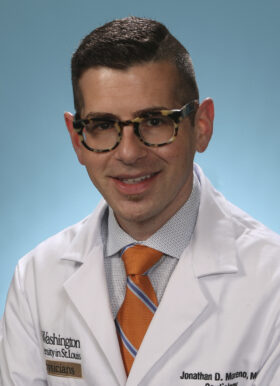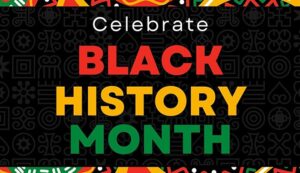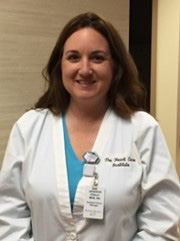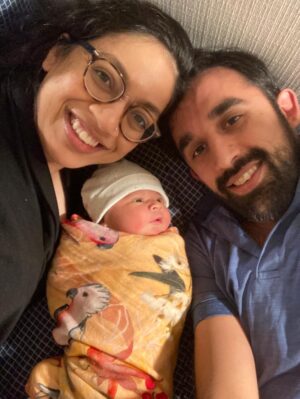Heart Matters – January/February 2023

Redefining Advanced Heart Failure

Today, patients with congestive heart failure have more treatment options than ever before, and traditional advanced therapies have greatly improved over the last decade. Nationally ranked in Cardiology and Heart Surgery by U.S. News & World Report, our advanced heart failure cardiologists at the Washington University and Barnes-Jewish Heart and Vascular Center work with patients’ current cardiologists and primary care physicians to provide them with the best possible outcomes. Jonathan Moreno, MD, PhD, assistant professor of medicine at the Washington University School of Medicine, says congestive heart failure patients who are referred early to an advanced heart failure specialist often have better outcomes.
Dr. Moreno recommends cardiologists and primary care physicians consider referring their patients if they:
- Are on continuous IV medications;
- Have worsening liver or kidney function along with their heart failure;
- Have worsening ejection fraction;
- Have been hospitalized more than once (or have visited the ER more than once) in the last 12 months;
- Experience increasing cardiac shock and are losing weight because of their heart failure;
- Fall into the New York Heart Association Class III or IV categories;
- Have edema;
- Have low blood pressure;
Dr. Moreno refers to the “I Need Help” chart from the American Heart Association, the American College of Cardiology, the Heart Failure Society of America and the European Society of Cardiology to determine when heart failure patients should be referred to the Washington University and Barnes-Jewish Heart and Vascular Center.
Dr. Moreno says once referred to the Heart and Vascular Center, patients meet with one of 10 advanced heart failure cardiologists. From there, patients meet with a social worker, surgeon, dietician, financial specialist and a LVAD/ transplant nurse coordinator. With the largest center in the region, our team of experts offers a complete range of treatments and personalized, multidisciplinary care for thousands of patients each year.
“Decades of experience, early adoption of state-of-the-art surgical techniques and innovative therapies allow our team of advanced heart failure cardiologists and surgeons to treat patients with all types and stages of heart disease. Our patient outcomes exceed national averages for all cardiology and heart procedures and conditions,” Dr. Moreno says. “We encourage early referrals and co-management with a patient’s local cardiologist. As a patient’s heart failure progresses, we already have a relationship with the cardiologist and the patient, and we can intervene early. Unfortunately, patients who are referred too late may have other organ failure which mean limited options.”
Advanced therapy choices, including LVAD and heart transplants, have improved over the last decade, Dr. Moreno adds. “A LVAD’s ability to extend life is incredible,” he says. “We can literally pull a LVAD off the shelf and it is a nice, durable strategy for a median of seven years. That’s a lot when you were given a death sentence.” Heart transplants now have a median life expectancy of 13 years, but they need early referral.
For more information about the Washington University and Barnes-Jewish Heart and Vascular Center, and to refer a patient, please call 314-362-7260.
Way to Shine!
“I would like to nominate the West county cardiology MA’s (Alana Yokely, Assia Yezzia, Shannon McCarthy) they have worked so hard. They have worked thru high turnovers, and we just want them to know we see them and they are appreciated.
Other Way to Shine’s for this month were Heidi Craddock, Carolyn Iezzi, Keeyonna Harrison, Stephen Tepen, Rojelio Delgado, Amanda Geisler and Ashley Edwards.
If you catch someone in the act of shining, contact or send an email to bolhafner@wustl.edu.
Celebrate Black History Month

During Black History month, we hope you have time to reflect on the many historical sacrifices and important contributions of Black Americans to our American way of life. We do this in the spirit of sharing:
- To build communities,
- To strengthen relationships,
- To critically look at and transform knowledge and its artifacts in how they are applied to Black Americans,
- To cultivate a culture of caring through deep listening to our patients and colleagues,
- To use history to imagine new ways of sharing in the opportunities and promises of discovery. Please see below for Black History Month events/activities being held at Washington University and in the St. Louis community. We also provide links for reading and viewing to guide your reflection beyond Black History Month.
Washington University has planned the following events for our community:
Washington University – School of Medicine Campus:
- February 10, 2023 from 11:45am – 1:00pm – Inclusive Excellence Speaker Series 2023: A conversation on “Critical Race Theory” with Kevin Brown hosted by the Office of Diversity, Equity & Inclusion (ODEI)
- February 23, 2032 from 4:00 – 5:30pm – 84th Historia Medica Lecture: ‘When Disparities Remain: The Enduring Legacy of Segregated Medicine’ hosted by Becker Medical Library
Washington University – Danforth Campus:
- The Brown School will host a series of talks throughout February. Click here for more information and to register to receive zoom links.
For more information on opportunities to reflect and engage in the celebration of Black History Month, visit this IDEAS at DOM news page.
The Science of St. Louis Blues with Dr. Mustafa Husaini
The St. Louis Blues NHL team and Washington University Physicians have collaborated with Barnes-Jewish Hospital to create a series of videos on the Science of Blues Hockey. Hosted by Karlie Kloss, the latest video features Dr. Mustafa Husaini, Cardiovascular Division faculty member and director of our sports cardiology program. Check it out here!
Dr. Alan Braverman on the Death of Journalist Grant Wahl at the World Cup
The Marfan Foundation is saddened to learn that journalist Grant Wahl has died due to complications of an ascending thoracic aortic aneurysm. Diagnosed, this condition can be treated if people and their health professionals know the risk and manageable complications.
The Foundation has expressed direct condolences to the Wahl family. His loss to family, friends, community, and professionals was heartbreaking. We commit to continued investment in science, patient support, and collaborative efforts that will make these tragic moments fewer and fewer.
Recently, the American Heart Association and American College of Cardiology published new guidelines for identifying and treating aortic disease. This information can be found on The Marfan Foundation website.
“About 20% of thoracic aortic aneurysms or aortic dissections are related to a genetic or heritable condition,” said Alan Braverman, MD, Alumni Endowed Professor in Cardiovascular Diseases and Professor of Medicine, Washington University School of Medicine, and Director, Marfan Syndrome and Aortopathy Clinic at Barnes-Jewish Hospital in St. Louis. “Some of these conditions are associated with syndromic or recognizable features (like Marfan, Loeys-Dietz, or Vascular Ehlers-Danlos syndrome (VEDS)), and others are limited to aortic and vascular disease alone (nonsyndromic). Genetic testing of individuals at risk for TAA or dissection can identify people at risk, but even in the absence of a discovered genetic variant, the first-degree relatives of the person with a TAA or aortic dissection should undergo aortic imaging with a CT, MRI or echocardiogram to determine if family members have aortic disease. Recognizing the outward features of these conditions and screening at-risk relatives may save a life.”
Dr. Braverman serves on the Marfan Foundation Professional Advisory Board and Board of Directors, the leading global nonprofit organization on Marfan syndrome, Loeys-Dietz, VEDS, and other genetic aortic and vascular conditions, was a member of the writing team for these November-published guidelines.
The Foundation, established more than 40 years ago, has been the leading advocate for aortic disease awareness and education since the death of Jonathan Larson, composer and playwright of RENT, who died of an undiagnosed aortic aneurysm and aortic dissection in 1995. Despite advances in treatment, an overwhelming challenge remains in diagnosis. – a situation similar to Grant Wahl.
Seven Days of Heart Self-Care
In honor of American Heart Month this February, we challenge you to give some love to your heart. Here is a seven day self-care plan that is sure to get you on the road to improving your heart health:
Everyone has heard that they need to eat healthier, but knowing what that actually means can be overwhelming and confusing. If your doctor has told you to lower your cholesterol to reduce your risk for heart disease, then you might try these food ideas.
Day 1 of self-care: Try at least one of the foods from the list in the article.
Did you know that you can feel fine and still be suffering from high blood pressure, also known as the “silent killer”? For that reason, it is recommended that you have your blood pressure checked at least once per year. If you also grapple with “white coat syndrome” (an increase in blood pressure due to the presence of a doctor or other medical professional), it is reasonable to use at-home cuffs or grocery store cuffs to get an idea of what your numbers are. Make sure that you remain quiet and calm for several minutes before taking the reading. Knowing your blood pressure and working with your medical team can be life-saving.
Day 2 of self-care: Check your blood pressure.
Sleep disorders can have an impact on heart health; therefore, it is important to know the signs of a sleep disorder. Because you are unconscious when asleep, asking a family member or person with whom you live about your sleep behaviors is informative.
Day 3 of self-care: Ask a loved one about your sleep quality.
Managing your weight is much easier said than done; however, obesity greatly increases your risk of heart health difficulties. If you have tried dieting and exercising with no success, there is still hope. Read the story of Elaine Lannom, who received an endoscopic sleeve gastroplasty (ESG) procedure from Vladimir M Kushnir, MD, to achieve her weight loss goals. If you feel that you have exhausted all options, speak with a physician to discuss next steps.
Day 4 of self-care: Make a plan for weight management and/or weight maintenance.
Sugar intake is closely linked to inflammation and heart disease. If you have a sweet tooth, try to snag a fruit instead of a treat. Moderating your refined sugar intake will help keep your heart healthy, keep your weight down and get you feeling more energized throughout your day.
Day 5 of self-care: Swap at least one sugary food for a fruit or vegetable.
Smoking and regularly coming into contact with cigarette smoke is detrimental to your overall health and especially to your heart health. If you need help quitting, you can visit the Living Well Center Smoking Cessation Program. Did you know that when you quit smoking you begin to experience health benefits within just half an hour?
Day 6 of self-care: Quit smoking today or avoid smoke as much as possible.
If lifting weights at a gym sounds intimidating, fear not. You can improve your heart health by focusing on increasing your physical activity by at least 30 minutes per day. Some ideas include dancing, swimming, walking and anything else that gets your body moving.
Day 7 of self-care: Try a new type of physical activity today for at least half an hour.
Health & Wellness
Healthy Carbohydrates
Emma Greenhill, MS, RD, LDN
Carbohydrates are an essential part of our diet. Carbohydrates are our bodies first energy source. Carbohydrates provide us with vitamins, minerals and fiber. However, not all carbs are as healthful as others. Let’s take a closer look at carbohydrates and see what would work best in our meal patterns.
Carbohydrates are found naturally in fruits, vegetables, grains, dairy and legumes. But there are three categories of carbohydrates: Sugars, Starches, and Fiber.
Sugars, which are often smaller molecules called monosaccharides and disaccharides. Sugars can be natural or added in by the manufacturer. Added sugars are found in processed snack foods, regular soda, candy and desserts. Sugars are also found naturally in vegetables, dairy and fruit. Two examples of these natural sugars are lactose and fructose. These natural sugars are not detrimental to our health like added sugars can be when eaten in large quantities.
Next are starches, these are complex carbohydrates. They come from grain products and starchy vegetables like potatoes, beans, corn, peas and winter squash. This ever includes sweet potatoes.
Lastly, is fiber which is also a complex carbohydrate. Fiber helps you stay full and aids in many aspects of health. It can be found in most plant foods, such as fruits, vegetables, legumes, nuts and whole grains. There are two types of fiber: Soluble and Insoluble. But most plant foods contain both kinds of fiber.
Unrefined carbohydrates are whole foods with minimal processing and they have the highest fiber and nutrient content. Sources of unrefined carbohydrates include fresh fruits, fresh vegetables, dried beans, farro, oats, quinoa. The fiber content in unrefined carbohydrates makes them slow to digest and leads to feeling fuller for longer.
Refined carbohydrates are not as healthful as their unrefined counterparts. These are found in processed convenience foods that have been stripped of some of their fiber and nutrients during the manufacturing process. These carbohydrates are quickly digested and can have a noticeable effect on blood sugars. Sources of refined carbohydrates include desserts, white pasta, white bread and many snack foods. We need to be mindful about portion sizes and frequency with these carbohydrates.
Remember to choose whole fruits, whole vegetables, whole grains and legumes to get the right kinds of carbohydrates incorporated into your meal patterns.
Tomato and Ricotta Toast

Serves: 4 • Prep Time: 5 minutes • Total Time: < 10 minutes
Skip the ordinary toast toppings and enjoy this herb cheese spread instead. It’s a delightful way to start off your day!
Ingredients
- 1 cup fat-free ricotta cheese
- 2 tablespoons chopped green onions, chives, or red onion
- 3/4 teaspoon dried Italian seasoning
- 1/8 teaspoon pepper
- 4 slices whole-grain or whole-wheat bread, toasted
- 2 to 3 medium tomatoes, thickly sliced
Directions
- In a small bowl, using a spoon or spatula, stir together the ricotta cheese, onions, Italian seasoning, and pepper.
- Spread 1/4 cup of the ricotta mixture over each slice of toast. Top with the tomato slices.
Recipe Tip
- Prefer a hot open-face sandwich for lunch? Simply place the toast on a baking sheet lined with aluminum foil and pop it under the broiler for 1 to 2 minutes, or until the ricotta cheese is melted.
Recipe courtesy of heart.org
Do you have BJC Cigna? Remember that you have annual coverage to meet with me, Emma Greenhill, a Heart Care Institute dietitian. Call 314-996-8165 for more insurance information or to schedule an appointment.
Scientist in the Spotlight: Lindsay Underhill’s career path in global health
Written by JingJing Zhu, medical student liaison, Global Health Student Advisory Committee, Global Health Center at the Institute for Public Health
The Washington University in St. Louis community encompasses many talented researchers of diverse academic interests and disciplines. As a member of the Global Health Student Advisory Committee, I recently spoke with Lindsay Underhill, PhD, MPH, a global environmental health researcher and instructor of medicine. Her research focuses on the implementation and effectiveness of built environment, behavioral, and health systems interventions aiming to reduce environmental exposures and chronic disease in the U.S. and global south.
My interest in public health began as an interdisciplinary Biology and Anthropology major at Wesleyan University, where I was able to explore my fascination with both natural science and the social and environmental factors influencing population health. This led me to pursue an MPH in environmental health at the Columbia University Mailman School of Public Health and a PhD in environmental epidemiology and exposure at the Boston University School of Public Health. Throughout this training, I was lucky to work with mentors who emphasized the importance of addressing equity and environmental justice at every research stage, including concept generation, analysis, and results dissemination. For my PhD, I collaborated with the National Institute of Standards and Technology to study the impacts of energy-efficient building retrofits on energy consumption, air pollution exposure, and health in low-income multifamily housing using building simulation models. Additionally, I spent three years in Peru as a project manager and co-investigator of several studies funded by the National Institutes of Health (NIH), including a pediatric asthma and urban air pollution study and a randomized controlled clean cooking intervention trial in Peru, Guatemala, India and Rwanda. In 2021, I was excited to join the Washington University School of Medicine faculty as an instructor and funded trainee in Dissemination and Implementation Science. In this role, I am a co-investigator of a randomized controlled trial to assess the implementation and effectiveness of a community health worker managed strategy to improve hypertension care in the Peruvian Andes. I also study the influence of geographic factors on exposure, health and the accessibility of health care services.
Following my early research experiences in Peru, I became committed to a career in global environmental health research. The science is fascinating, the collaborations with global researchers are energizing. The research on social and environmental determinants of global health is much needed and rewarding, and the travel is educational and exciting.
Spend a significant time outside your home country! (A week or month won’t cut it.) Look for funding that values global research and long-term participation in on-the-ground field activities (e.g., from the NIH Fogarty Institute). In particular, spend significant time at project sites to 1) better understand the extent of local project management, resources, and technical expertise that is required to conduct human subjects research, and 2) take the opportunity to listen and learn from local leadership, find context-appropriate ways to contribute, and build long-term partnerships.
Meet Your Colleague

Jennifer Kilburn
Nurse Manager, HCI Cardiac Diagnostic Lab
Fun Facts About Jennifer
How long in the division: I have been at HCI going on 8 years
Prior to HCI I worked 25 years at BJH with cardiac cath lab and CCU experience
Family: I am married with 2 children oldest daughter in college and son sophomore in HS.
Hobby: We spend a lot of time attending sporting events and traveling with our son, baseball is his primary sport. I love the outdoors, hiking, parks, lakes, gardening and taking our 2 golden retrievers on walks.
Favorite Food: Seafood
Nickname: RIP (As a kid I loved to sleep, and still do)
Bucket List: Exploring the west and South African safari tour
Cardiovascular Division Staffing Updates
- JR70488 – Research Nurse Coordinator II
- JR70780 – Clinical Specialist PT/OT
- JR72048 – Coordinator Laboratory Support Services
- JR71712 – Ultrasound Sonographer
- JR71689 – Clinic Administrator
- JR71691 – Coordinator Residency/Fellowship
- JR72346 – Billing Scheduling Associate I
- JR72358 – Billing Scheduling Associate II
- JR72337 – Clinical Research Coordinator I
- JR72294 – Research Technician II
- JR72497 – Clinical Research Study Assistant II
- 1/9/2023 – Amy Ronsick, Research Nurse Coordinator l
- 1/9/2023 – Melissa Lovell, Clinical Nurse Coordinator
- 1/10/2023 – Caitlin Douglass, Research Nurse Coordinator I
- 1/16/2023 – Monica Xiaoran, Research Technician I
- 1/17/2023 – April Smith, Medical Assistant II
- 2/1/2023 – Tejiri Agbigbe, Clinical Research Coordinator I
- 2/6/2023 – Alexis Sherman, Nurse Practitioner
- 2/6/2023 – Julianna Kretzinger, Medical Assistant III
- 2/13/2023 – Corriauna Harper, Medical Assistant II
- 2/13/2023 – Brianna Scantlin, Medical Secretary II
- 2/20/2023 – Lynn-Elizabeth Tullis, Practice Office Manager
Farewell to these Cardiovascular Division employees. Thank you for your service, you will be missed!
- Kelly Keenan, last day is 2/10
- Linda Lawson, last day is 2/10
- Stephanie Sykes, last day is 2/10
Introducing: Ahaan Anthony Agarwal Wanduragala!

Dr. Anubha Agarwal welcomed a new addition to her family on New Year’s Day! Ahaan Anthony Agarwal Wanduragala was born on January 1st, 2023 at 12:25 AM, weighing 9 lb 1 oz and was the second baby born in 2023 in St. Louis.
Dr. Agarwal says “Ahaan means ‘first ray of light’ or ‘dawn’ in Sanskrit and is a name that holds meaning across many geographies and cultures, reflecting our hope for him to bring light to other’s lives and be a citizen of the world. In his first few days of life, he has made clear he does not like diaper changes but loves milk and cuddles, especially with his grandparents.”
Congratulations to the family!
Upcoming Events
- Save the Date: Take Care Health Fair March 1 at EPNEC
- Occupational Health Hosting COVID-19 Booster Walk-in Clinics:
Employees can walk-in every Friday for a COVID-19 booster Jan. 13 to Feb. 24 from 8 a.m. to 3 p.m.
In a continued effort to protect our community and the St. Louis region, Occupational Health Services will host walk-in COVID-19 booster clinics for any WashU employee every Friday beginning Jan. 13 through Feb. 24, 2023. The walk-in clinics will provide COVID-19 booster shots each Friday from 8 a.m – 3 p.m. at the Occupational Health Services clinic, which is located at the Center for Advanced Medicine (CAM), Suite 5A. There is no need to schedule an appointment for the walk-in clinics.
Visit Occupational Health Services online for contact information or to find the latest on-campus COVID-19 vaccine information. Family members, including a spouse, partner and/or dependent(s), can find COVID-19 booster shots at a local pharmacy or can schedule an appointment through WUCare, a dedicated primary care clinic for WashU employees and dependents ages 18+, if enrolled in a WashU health plan.
Updates to the Washington University Retirement Savings Plan
Updates to the Washington University Retirement Savings Plan
Effective February 6, 2023, several updates are being made to the investment options available under the Washington University Retirement Savings Plan. A transition guide (pdf) is now available and provides details on the new funds that are being added to the investment lineup and lists the investment options that are being replaced.
It is important to note that no action is required by you as a part of this change. However, you should review the transition guide and your account to see how these investment option changes may affect you. If applicable, your account balance and your future contributions will automatically map to the funds that most closely match your current investment mix. After this mapping occurs, you always have the option of selecting the investment options of your choice.
Instructions to view and/or update your account:
- Online: Visit TIAA.org/wustl and log in. If you’re new to TIAA, select Log in, then Register for online access. Follow the on-screen directions to access your account.
- Phone: Call TIAA at 800-842-2252, weekdays, 7 a.m. to 9 p.m. (CT).
Please keep in mind that as a Washington University Retirement Savings Plan participant, you have access to personalized advice on the Plan’s investment options from a TIAA financial consultant at no additional cost to you. Schedule a session online by visiting TIAA.org/schedulenow or by calling 800-732-8353, weekdays, 7 a.m. to 7 p.m. (CT).
2022 Tax Documents Available Online
Employees will be able to access W-2 statements in Workday as of Jan. 31, 2022. 1095-C forms will be available in Workday in early March. Employees are encouraged to sign up to receive electronic 1095-C forms by Feb. 10 to ensure timely delivery. Please remind your team members of these important dates.
IT Spotlight: Multi-Factor Authentication

Most of the time, using an online service – checking email, shopping, and using social media – requires users to log into an account with a password. As we covered in the Password-based Authentication article, passwords are “something known,” so they can be leaked. And security breaches happen often. Recently, LastPass had its second security breach in three months from the same group. You can see if any of your accounts were involved in a breach at Have I Been Pwned. Fortunately, there is a simple and effective step we can take to further secure our valuable accounts: multi-factor authentication.
Even if you use a long, random password, hackers have measures to steal or guess them anyway.
- Phishing attacks can trick someone into giving up their credentials. If you receive a “phishy” email, please protect yourself and others by using the Phish Alert Button.
- Hackers can purchase credentials from a data breach and log in using those credentials. If you discover that your account information may have been exposed in a breach, immediately change your password.
- If you use the same password in more than one account, a hacker may be able to reuse your stolen password for your other accounts. Never reuse the same password.
- If your password is simple or one of the most common passwords, then it can take a computer minutes or even seconds to guess your password.
The best first step in defending your account from hackers is to harden your password. If you see fit to change your WUSTL Key password, you can read the guide at How do I Change my WUSTL Key Password – Information Technology. After strengthening your password, the best way to protect an account is to use multi-factor authentication.
If you have been following our authentication series, then you may remember that authentication falls into three categories:
- Something you know – like a password, Personal Identification Number (PIN), or the answer to a security question.
- Something you have – tokens like a smart card, memory card, or even a one-time verification code.
- Something you are – biometrics like your fingerprint, face, or retina.
An account with only one authentication factor is not nearly as secure as an account that uses a combination of factors. Calling back to an earlier example, an ATM at Chase Bank requires customers to provide their debit card and their personal identification number (PIN). This way, if a thief steals or duplicates someone’s bank card, they cannot withdraw money without the second factor: the account’s PIN.
Follow the Cardiovascular Division on Twitter!
Check out our division account, @WashUCardiology! We will be sharing division accomplishments, announcements, news, events, and more. If you have a story about the cardiovascular division that you think deserves a social media spotlight, email bolhafner@wustl.edu.
Photo Directories
Washington University School of Medicine Cardiovascular Division
cardiology.wustl.edu
Follow Us on Twitter: @WashUCardiology